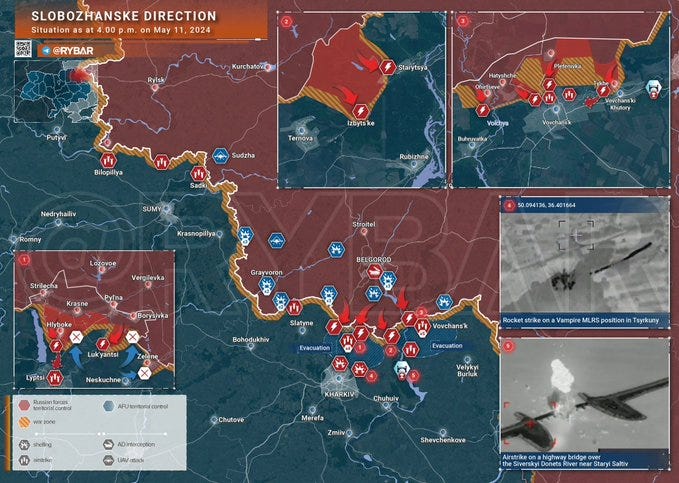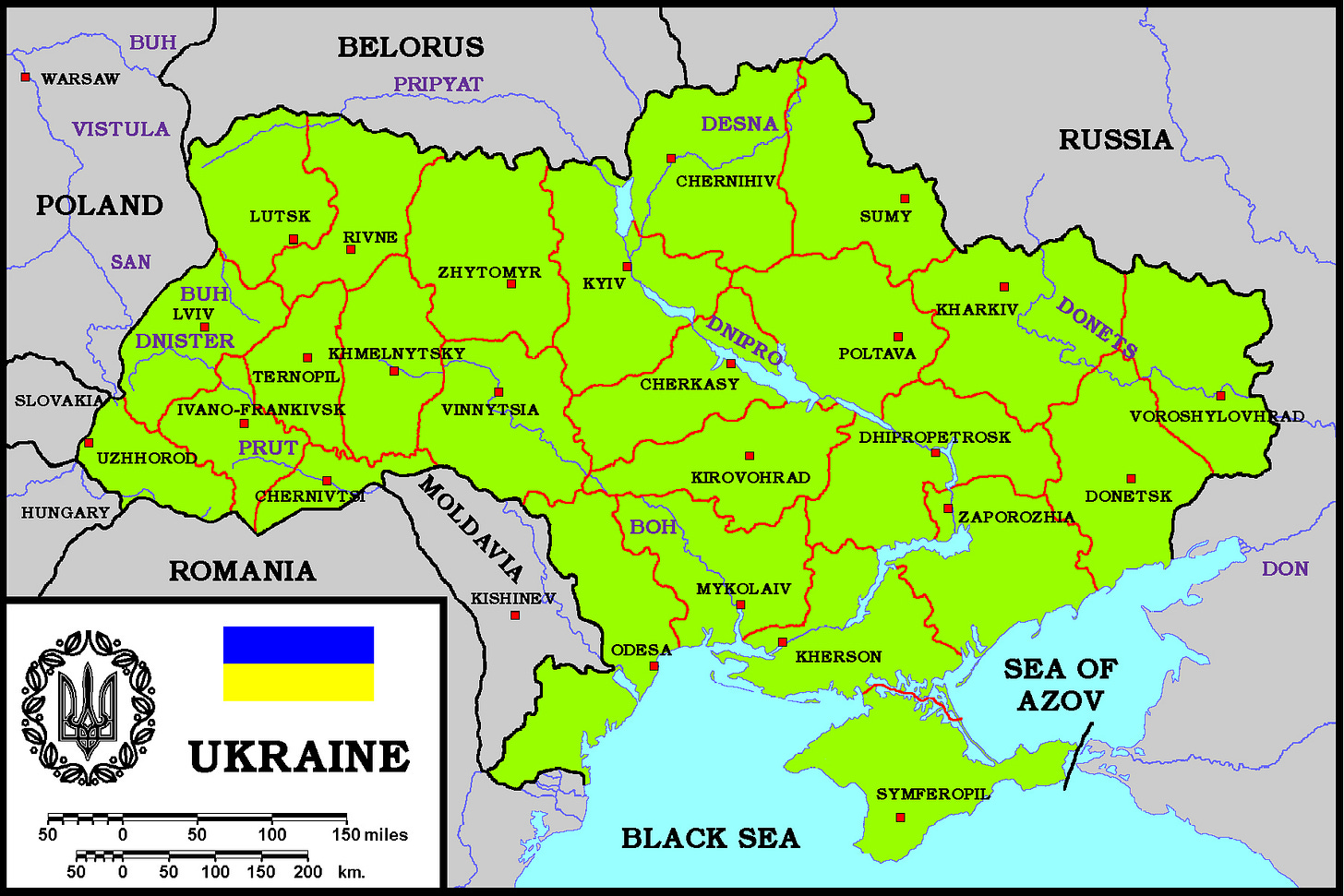I long ago stopped trying to keep up with daily activity on the Ukraine front of the Neocon War on the World. Lacking the expertise or in depth knowledge of events on the ground, I have no way of assessing any big picture significance that may emerge from such granular data on a daily basis. However, there’s a significant buzz over Russian activity in the Kharkov direction (that’s the Russian spelling, it’s Kharkiv in Ukrainian). Emerging reports suggest that this could be the beginning of something major, as the muddy spring season draws toward its end.
My idea on how to understand current operations in Ukraine rests on the dichotomy of a war of maneuver versus a war of attrition. The West has continually urged Ukraine to conduct a war of maneuver, in supposed opposition to frontal assaults on established defensive lines. The problem is that Ukraine simply lacks the combination of trained manpower and the required offensive equipment and munitions to conduct such a war. First, it lacks the resources to effect any decisive breakthrough of Russian defenses which could then be exploited—as we saw in the spectacularly failed Spring-Summer-Fall “offensive” that never got off the ground. Second, maneuvering ground forces require air cover to survive. Russia has dominated the air over the lines of contact from the beginning and has degraded Western supplied air defense systems to the point that its air operations are now extending ever more deeply into the Ukrainian rear areas.
The Russians are therefore in a position—time consuming but ultimately effective—to simply advance under strong protection where opportunity affords until they meet strong opposition. The Ukrainian opposition can then be destroyed on open ground or, if the Ukrainians are able to establish defensive lines, the advance can then stop while the Ukrainian opposition is degraded with artillery, missiles, and now with powerful FAB bombs. The problem of fortress cities occupied by Ukraine, established over the past 8 years, remains. The Russians are dealing with those situations methodically. In the meantime, Ukraine is finding it impossible to plug all the holes in its defenses that Russia is exploiting. Most of this action is taking place on a roughly north-south line in the Donbass.
MoA presents three options for understanding the new Russian activity north of Kharkov. This is a good place to start, as MoA is presenting a relatively cautious evaluation:
Ukraine SitRep: The 'Sanitary Zone' On The Northern Border With Russia
The opening of a new front towards the Kharkiv region might have one or more of three purposes.
To surround and eventually take Kharkiv city, the second biggest one in Ukraine.
To create a buffer zone along the border to prevent Ukrainian attacks on Russian grounds.
To divert Ukrainian reserves and to prevent them from joining the intensifying fight in the Donbas region.
First of all, at this point it appears that Russia is only probing—using motorized units to probe Ukrainian mechanized formations. Regardless of developments, MoA discounts #1, as there are no signs that Russia is putting the forces in place to take on a city of 1 million. #2 seems a logical subsidiary goal. #3 seems the most likely—the goal being to force Ukraine to commit reserves over a wide area, forcing those reserves to come out into the open and engage the Russian forces, at which time they can be fixed in place and destroyed from the air. In that regard, it’s important to note that multiple sources are reporting what look like preparations for heavier Russiaan attacks. These preparations extend northwest from Kharkov to Sumy and even as far as Chernigov. These preparations have included extensive destruction of rail, bridge, and electric power facilities. The idea appears to be to cut off the ability of Ukrainian units to maneuver once they are deployed, forcing them to fight or surrender.
Here are two maps to give the lay of the land. You’ll find Kharkov at the bottom middle, and you can then find Sumy by following a straight line from Kharkov half way to the NW corner:
Next we zoom out, as it were. This map uses Ukrainian spellings. Find Kharkiv and Sumy along the NE borders with Russia. Chernihiv is at the top middle.
So now we turn to Simplicius’ assessment. Like MoA, Simplicius discounts an imminent assault on Kharkov city itself but, based on the reports of preparations further NW around Sumy, Simplicius draws some further implications. First Kharkov:
Russia will likely see how Ukraine reacts to the Kharkov incursion, watch where it deploys its reserves, and act accordingly, with potential Sumy and/or Chernigov contingents to come in much later.
The objective here is not to take Kharkov any time soon. That can happen much, much later in an organic fashion as a byproduct of far more exigent objectives, like cutting off the Kupyansk corridor for the AFU. Little by little, Russia will worm its way in and surround Kharkov, which will be besieged and likely fall very slowly, maybe even by mid 2025 or so. They’re not in a rush to capture it any time soon as doing so is not necessary for the time being, nor would provide any recognizable strategic benefit.
Remember: the objectives right now are to degrade and destroy the AFU manpower, not to “capture territory”—that will all come as a natural secondary byproduct of its own.
In the meantime, Russia is slowly degrading the logistics in the region:
Simplicius produces a Ukrainian claim that these are all diversionary moves, to draw Ukrainian reserves away from Donbass:
In the meantime, Ukrainian commanders wisely note that the northern actions are merely distractions and fixing operations for a reinforced campaign through the center in the Donetsk region:
The problem is that, given massive Russian superiority in manpower and firepower, Ukraine cannot afford to ignore Russian “diversionary” moves. If they do, the Russians will simply continue advancing and, as Simplicius notes, that advance could take on a life and momentum of its own—potentially cutting all Ukrainian supply lines to the East in Donbass. “The trickle could turn into a deluge” if ignored. But then, if Ukrainian reserves are sent North, those reserves have to come from somewhere else. The South, where Russia has several well supplied armies in place, ready to take the offensive? It’s all a gamble for the Ukrainians, which is exactly how the Russians—who have aces up their sleeve—want it.
Simplicius draws the analogy of this situation to a chess game. He doesn’t put it in exactly these terms, but the implication is definitely there. This is like a chess game in which the Ukrainians are left with their King, some pawns, and half or less of their Rooks/Bishops/Knights. Against a Russian opponent at full strength. There’s no space for meaningful maneuver for the Ukrainians, and the Russians can force attrition on the Ukrainians with minimal losses to themselves. The play is out in the open—everyone can see the chessboard—but that will make no difference, except that everyone knows and can see what the end will be.
… all modern warfare, we now know, is no longer contingent on element of surprise. Russia knows that Ukraine knows, and Ukraine knows that Russia knows that Ukraine knows. It’s that type of situation—and it doesn’t matter. Despite advance warning and accurate intel, Ukraine can do nothing about the events that are soon to come. This is a chess match and a numbers game; you can “know” full well the constrictor is tightening over your chest, but there will be little you can do about it. Ukraine will lack the means to respond to the constant swell of Russian troops and armaments on every single frontline, which will only stretch longer and longer as Russia potentially introduces new breaches into Sumy, Chernigov, and perhaps even elsewhere …
So yes, Ukraine will know full well what Russia is doing—but this by no means allows them to have the situation “under control”. They can send their reserves to Kharkov, then they’ll get run through in the Pokrovsk direction. Should they choose to ‘split the difference’ and go half and half, then they’ll just get worn down and overrun in both directions; it’s really that simple. Recall all the quotes from Ukrainian officers I recently posted wherein they admitted they don’t have the mobility to match Russian ‘whack-a-mole’ tactics. Russia can transfer units from one region to another and mesmerize the AFU with the ‘thousand cuts’ from every angle, and Ukraine simply doesn’t have the logistical infrastructure to keep up plugging each hole. The longer the front stretches, the worse this issue becomes.
All in all, things are shaping up right on schedule.
In other words, the Russian buildup has reached the point where we can speak of a real inflection point. A Ukrainian collapse at any point could lead to a cascade of further collapses. That is probably what the Russians are up to—shaping the battlefield to produce exactly that result.





Correct assessment. The Russians will keep on probing until something breaks. I wonder how Victoria Nudelman is feeling today?
Ukraine precipitated this action by bombing civilian targets across the border especially in Belgorod. Seems like very odd behaviour.
The Western curators for some reason wanted Russia to react in this manner.